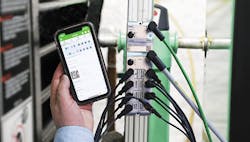Flexibility redefines input/output expectations
From the perspective of speed and responsiveness of automation, the process industry’s packaging, paper, plastics and textile manufacturing applications are among its most challenging. Conveyors, continuous sheets and webs are moving faster than ever, even as the volume of real-time data needed to feed industry’s digital transformation ambitions continues to mount. So, how can a maker of the industrial networks and input/output (I/O) systems that make all this happen continue to keep pace with the mounting demands of end users and machine builders?
To find out, Control caught up with Charlie Norz, product manager for I/O systems at Wago USA.
Q: Over the past several years, more and more machine I/O has been migrating out of the protection of control enclosures and onto the machine itself, closer to the action and the tough conditions that often entails. What technologies and product features have made this migration possible and what are the benefits to be gained?
Product Manager, I/O Systems, Wago USA
www.wago.com/us/discover-io-systems/field
A: The migration of I/O from the control panel to the machine is made possible by networking technologies that reduce the cost of distributed I/O while increasing system performance. The proliferation of high-performance yet relatively economical Ethernet-based distributed I/O is one factor. These devices offer the low latency required for more and more applications. We’ve also seen IO-Link protocol becoming more accepted for connecting with sensors, actuators and other industrial components. IO-Link delivers high performance with the bonus of device health data that can be used to increase productivity. In this age of digitalization, end users are implementing strategies to take advantage of device data to help increase production rates, while reducing downtime and, of course, increasing quality.
Q: Wago’s I/O System Field also features Bluetooth connectivity, which I believe is a first among I/O modules. What new possibilities does Bluetooth bring to the party?
A: Everybody's used to using mobile applications in their daily lives, and with remote devices like sensors and actuators becoming smarter all the time and using technologies like IO-Link, an instrument now provides a wealth of information in real-time about what it’s measuring as well as about itself. This also means these devices are becoming more complex, often requiring configuration during commissioning.
So, we've added Bluetooth to our IP67-rated distributed devices, so technicians and engineers can stand in line of sight of the I/O block and the sensor, while using their cell phone or tablet to configure the device or monitor the data in real-time. This is much more convenient than trying to commission a device over a wired network from an engineering station a few rooms away. And we see that using a mobile app to configure or monitor real-time data helps speed commissioning and troubleshooting.
Q: One key aspect of I/O system flexibility is in the variety of options available for connecting to field devices and supervisory systems. Besides IO-Link, are there any significant usage trends among the device connectivity options preferred by users and machine builders?
A: It’s no surprise that traditional industrial Ethernet protocols like EtherNet/IP and Profinet are most used for distributed I/O. However, we're seeing more users moving to OPC UA and MQTT over Ethernet for SCADA and even cloud-based applications. These two protocols offer benefits for IoT applications and are becoming the de facto standard for plant-floor-to-enterprise connectivity. We see users still deploying traditional fieldbus protocols, but they're also converging with that IT layer, and using technologies like OPC UA and MQTT.
Ethernet is also flexible and can run more than one protocol at the same time over the same wire. So, PLCs and HMIs can tap real-time information for their basic control functions via Ethernet-based fieldbuses, even as higher-level, top-side systems can exchange data via OPC UA at the same time. In this way, data can be routed at the same time to multiple systems, and the systems can each use the protocols they prefer.
Q: With a decided move toward converged IT/OT architectures that feature Ethernet-based protocols—including IP-addressable I/O modules and the risks that can represent—how do you go about ensuring that those devices remain secure from cyber-threats?
A: Network security is paramount today for plant-floor devices. We recommend that our customers use defense-in-depth methods to help prevent cyber-attacks. A good start is to zone the plant floor with different network segments to isolate systems. A second way to manage risks is by reducing physical and network access to your network devices. For example, using WAGO's lean managed switches in lieu of unmanaged switches enables users to turn off unused ports to help reduce unwanted access to a network. Lean managed switches can also enable users to set up rules that allow only approved devices to be used in the network. And in those cases, when it’s just not possible to secure your network cabling or infrastructure, we recommend encrypting plant-floor data using a technology like MACsec security.
Q: Talk of MQTT and cloud connectivity for an I/O module certainly makes sense from the perspective of emerging Industrial IoT applications, but how do you make sure those secondary communications don’t bog down the primary business of real-time execution of control tasks?
A: With digitalization of the plant floor in full swing, it might seem that sending all that real-time data to the cloud would be necessary and desirable. However, many users find that sending all that plant-floor data to the cloud is unproductive—plus, it's really expensive. So, we're now seeing architectures designed with edge-of-network devices like WAGO’s Edge Controllers and Edge Computers that are on-premise to contextualize and summarize data before sending it to the cloud.
These edge devices are running analytics locally to reduce latency, as well as reducing data storage costs. The amount of data transmitted and stored is greatly reduced. And the information that's sent to the cloud is enriched, so that those top-side applications still perform at a high level.


